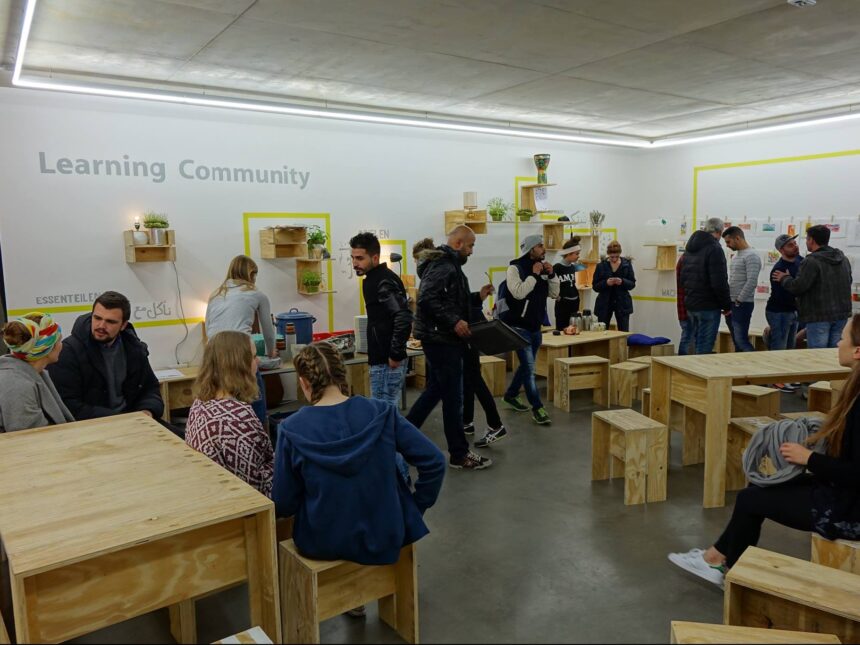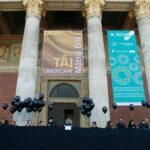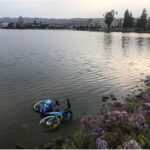From Protest to the Production of Social Relations: Socially Engaged Art and Activism in Germany since 2015
Karen van den Berg
Even before a severe crisis of liberalism was diagnosed following the Brexit referendum and the US elections in 2016, Germany had been in a state of political emergency. Equally, there had already been a decisive turning point in the development of activist art in Germany before this international political development was widely recognized. A look into 2014 will help to understand these changes.
On November 9th, 2014, shortly before the 25th anniversary of the fall of the Berlin Wall, the German performance collective “Zentrum für Politische Schönheit” kidnapped a series of commemorative plaques, which were placed in front of the Reichstag to commemorate the victims of the Berlin Wall. The collective took the plaques in order to erect them again on the European border fence in southern Europe to remember the victims of the current deadly barriers. At the time, the political landscape in Germany was not yet what it would be less than a year later, when Angela Merkel’s government temporarily suspended the Dublin Agreement. The arrival of some 800,000 refugees in the summer of 2015 was as much of a surprise for many as the unprecedented wave of readiness to help, in which the Germans intoxicated themselves for some time. Countless initiatives were formed and according to some statistics, one in five Germans was involved in providing refugee aid.[1] Many of these projects were based on activist initiatives that had emerged in previous years, some of which had been conceived by artists. Precisely because the political shift to the right and the resurgence of resentment-driven right-wing populism accompanied the wave of general commitment of the civil society from the very beginning, certain socially committed art forms, which were rather marginal before 2015, have become a matter of course. Demonstrating this development, German art foundations and state governments have established funding lines exclusively for socially engaged art projects.[2]
However, this development was not solely due to the wave of refugees. Another deeper cause for this change might be that within the meritocratic, so-called “Aspirational Class,” civil society involvement with an artistic touch has become a new norm because of its specific affinity for education and creativity.[3] An additional reason might be that the new post-bourgeois liberal mainstream understands working with artistic and creative means as an antidote to conservative nationalists’ concepts of culture and as a kind of defense of their own territory. Yet, what is the essence of these new practices? This can be shown in contrast to the example of the “Centre for Political Beauty” (ZPS).
In 2014, the aforementioned project by ZPS was all about drawing attention to the refugee crisis. But with their highly controversial action, in which the collective intended to commemorate the thousands of victims of the European border fence, the artists’ collective primarily drew public attention to themselves. In the following years, the actions of the ZPS, probably Germany’s best-known activist group, became increasingly spectacular. The climax was the “Eating Refugees” campaign in the summer of 2016, during which an arena with a tiger enclosure was set up in front of the “Maxim Gorki Theater” in Berlin. Refugees announced that they would voluntarily be fed to the tigers in this arena if the German government continued to ban the transport of refugees by plane.[4]
With their strategy of crossing ethical lines accompanied by putting the limits of artistic freedom to the test, the collective follows the tradition of Christoph Schlingensief. In their latest project, they trolled a leading right-wing populist—the AfD politician Björn Höcke—by placing a scaled-down copy of the Berlin Holocaust Memorial on his neighbor’s property and claiming to monitor the politician around the clock. This example also shows that the projects of the collective rely on fake news and extensive media coverage. With cunning tricks and the campaign’s irritating ambiguity they seek above all to realign the ethical compass of the nation.[5]
Today, the ZPS is surrounded by a wide variety of other activist projects that are not interested in such provocative, sometimes even satirical gestures and strategies. In many recent politically and socially committed art projects, the question of the limits of art no longer plays a central role. They dedicate themselves to something completely different and—to evoke Michael Hardt—focus on the production of new social relationships and ways of life.[6] This means that more and more projects are working sustainably and remain less interventionist. And as a result, the line between artistic and social initiatives is becoming increasingly blurred—a development that has been called “Social Practice Art” in the USA for some time.
Considering this development, it is remarkable that these new forms of activist and socially committed art in Germany are not only native to free, self-organized project spaces and initiatives. Instead, a growing number of public theaters have evolved into important platforms for political and social projects, especially since the autumn of 2015. As early as 2014, the performance group Baltic Raw transformed the action space of the leading German performance art venue “Kampnagel” in Hamburg into a refugee shelter and designated this project as a permanent performance.[7]
After the wave of refugees fleeing to Germany in 2015, a series of theater foyers became cafés and soup kitchens for the fugitives. The Schauspielhaus Dresden established a Monday Café in 2015, and the Kammerspiele in Munich initiated its “Welcome Café” in 2016.[8]
Older independent initiatives served as models, for example the “New Neighbourhood Moabit,” a meeting center founded in 2013 by the Belarusian artist Marina Naprushkina, where informal language learning workshops, a café set up by refugees, concerts, readings, and art workshops still exist and take place today.[9] Initiatives such as the “Grandhotel Cosmopolis,” a hotel jointly founded by artists, volunteers, and refugees in Augsburg in 2012, became role models.[10] Since 2015, the “raumlaborberlin” architectural collective has been setting up meeting platforms at various locations—including our own university’s exhibition space—for refugees and local citizens. Activists such as Hamburg based artist Margit Czenki organized film and photography workshops to develop basic, self-determined forms of articulation between the newcomers and the majority society.

Of course, this general euphoria has also given rise to many questionable and embarrassing projects. For example, the “Green Lights Workshops” by Berlin-based Icelandic artist Olafur Eliasson at the Venice Biennale 2017, in which refugees and exhibition visitors assembled prefabricated lamps before the eyes of the international art audience [11], hardly inspires the development of new productive social relationships. Against the background of such well-meaning but unsustainable, paternalistic, and to some extent voyeuristic projects, it is more than understandable that the refugee organization RISE, for example, felt compelled to issue a working directive for artists in order to protect traumatized refugees from being captured by art projects.[12]
Nevertheless, socially committed art forms have been developed and refined through constantly increasing reflection and criticism at the same time. Theater venues in particular have worked to establish a debate on right-wing populism, although somewhat hesitantly. The projects taking place there have demonstrated that it is impossible to come to terms with resentment-driven thinking by excluding it from political debates.[13] And it is precisely for this reason that it seems indispensable to develop formats that provide new modes of exchange and discussion.
Following the great wave of criticism of capitalism in the wake of “Occupy Wall Street” in 2011 and the hype of art projects with refugees in 2016, new projects are emerging today that work precisely on the problem of living together in an increasingly divided society. The question is how cohesion can be achieved in times of gradual social and economic ghettoization and how to develop new forms of living and urban habitats.
Such current examples include, for example, the alliance of seven German-language theater and dance production houses working under the headline “Claiming Common Spaces.”[14] This alliance deals with the challenges of social integration tasks in panels, workshops, and actions in public space at very different levels.
However, many of the initiatives that have been working in the “Right to the City” area for some time have also undergone a new development. They are now progressively transforming the activist protest mode into sustainable, interdisciplinary planning initiatives and also appear to have a new artistic self-image. Currently, more and more projects are counting on the creativity of the many in an increasingly convincing way. Projects such as “PlanBude” in Hamburg and the project “Fabric. Planung als Plattform” in Lörrach in southern Germany, for example, have developed elaborate techniques to trigger a kind of dissident mass creativity and collective wish production to determine the development of entire city districts by transforming performative planning processes into sustainable work.[15] Meanwhile, such practices are more and more frequently being used in destitute and migrant cities. For example, the head of the cultural office of the city of Offenbach closely works with the independent scene of activists who are committed to an inclusive society.

Nevertheless, a direct artistic confrontation with right-wing populists that goes beyond the creative left-wing counter-protest remains largely a desideratum [16], and the rise of socially engaged art has not yet lead to projects trying to produce new forms of social relationships with populists. Is this because it is not the way to deal with them, or is it because right-wing, resentment-driven convictions are quite widespread among the so-called socially weak, with whom artists often work in the field of “Social Practice Art”? In any case, it could be that many artists shy away from this challenge.
Now we can finally ask, what are the reasons for the rise of socially engaged art projects? In Germany, it is certainly not only the sudden wave of migration. But is it the withdrawal of the welfare state instead, a neoliberalization combined with a meritocratization of the society? Does a performance-oriented but also privileged new “Aspirational Class”[17] compensate for its feelings of guilt through civil society commitment, because we no longer feel innocent as residents of the Global North? Or is cooperative action with artistic means an indispensable antidote to a nationalist culture of vested rights protection controlled by resentment? Is the rise of socially engaged art therefore likely to continue? Or will a more and more widespread discrediting of socially committed actors as “Gutmenschen” (do-gooders) poison the rise of Social Practice Art? Finally, it seems that a collective activation of the “sense of possibility” (Robert Musil) has become more important than ever before. We can thus only hope that a new “creativity of the many” offers ways out of the political and social impasse.
Karen van den Berg (born 1963) is professor for Art Theory and Curating at Zeppelin University. She studied Art History, Classical Archeology and Nordic Philology in Saarbrücken and Basel. Her PhD thesis on Matthias Grünewald has been supervised by Gottfried Boehm and received support through a stipend of the Friedrich-Naumann-Stiftung. Van den Berg also earned the Max Imdahl-Stipendium für Kunstvermittlung between 1994 and 1996 and between 1993 and 2003 she has been a regular lecturer and research fellow at the chair for Art Science at University Witten/Herdecke. Research-stays and teaching brought her to numerous internationally acclaimed institutions including the Chinati Foundation in Marfa (Texas), Bauhaus University Weimar, Parsons New School for Design in New York City and to the Europäisches Kolleg Jena. She also served as visiting scholar at the Department of Comparative Literature at Stanford University and as a fellow at IKKM in Weimar. Her research focuses on art and politics, artistic episteme, art market studies and studio practice, theory and history of displaying, museums, and educational architecture.
Endnotes
[1] See https://www.zeit.de/gesellschaft/zeitgeschehen/2017-03/bertelsmann-stiftung-fluechtlingshilfe-muslime-christen-athisten.
[2] See for example: https://mwk.baden-wuerttemberg.de/de/service/presse/pressemitteilung/pid/mwk-sonderprogramm-gesellschaftlicher-zusammenhalt-foerderung-von-kuenstlerischen-und-kultur/; https://www.kultur-oeffnet-welten.de/startseite.html. ]
[3] Elizabeth Currid-Halkett, The Sum of Small Things: A Theory of the Aspirational Class (Princeton: Princeton University Press, 2017).
[4] For the media resonance, see, for example, Mareike Nieberding, “Die Eskalationsbeauftragten,” Der Spiegel 26 (2015), 134-135; Christian Jakob, “Krasser Scheiß,” Taz, June 21, 2016. http://www.taz.de/!5311127/. Cf. for the discussion in the German Bundestag: https://www.zdf.de/politik/frontal-21/eu-tuerkei-abkommen-umstrittener-fluechtlingsdeal-100.html (min 2:02).; Frank Henkel, “Verabscheuungswürdige Tat,” Der Tagesspiegel, November 8, 2014. http://www.tagesspiegel.de/berlin/gestohlene-mauerkreuze-und-das-gorki-theater-frank-henkel-verabscheuungswuerdige-tat/10953356.html
[5] About their actions, see Karen van den Berg, “Riskante Manöver. Das Zentrum für Politische Schönheit (ZPS) und die politische Wahrheit der Illusion,” in Haltung als Handlung – Das Zentrum für politische Schönheit, eds. Raimar Stange, Miriam Rummel, Florian Waldvogel (München: Edition Metzel, 2018), 304-320.
[6] Michael Hardt, “Production and Distribution of the Common,” in Being an Artist in Post-Fordist Times, eds. Pascal Gielen and Paul De Bruyne (Rotterdam, 2009), 52.
[7] http://www.stiftung-do.org/2015/ecofavela-lampedusa-nord/
[8] See http://www.staatsschauspiel-dresden.de/spielplan/a-z/montagscafe/; https://www.muenchner-kammerspiele.de/inszenierung/welcome-cafe.
[9] See www.neuenachbarschaft.de and Karen van den Berg, “Damit wir uns besser fühlen? Eine kleine Kartierung sozial engagierter Kunst,” in Intermedialität und Performativität in den Künstlerischen Therapien, ed. Peter Sinapius (Hamburg, Potsdam, Berlin: HPB University Press, 2018), 186–221.
[10] See https://grandhotel-cosmopolis.org/de/ and also the “Bellevue di Monaco” in Munich, www.bellevuedimonaco.de.
[11] For a critical standpoint, see Wolfgang Ullrich, “Kunst und Flüchtlinge: Ausbeutung statt Einfühlung,” Perlentaucher, June 20, 2016. https://www.perlentaucher.de/essay/wolfgang-ullrich-ueber-kunst-und-fluechtlinge.html.
[12] Tania Canas, “10 things you need to consider if you are an artist—not of the refugee and asylum seeker community—looking to work with our community,” 2015, http://riserefugee.org/10-things-you-need-to-consider-if-you-are-an-artist-not-of-the-refugee-and-asylum-seeker-community-looking-to-work-with-our-community/.
[13] See Thomas Wagner, Die Angstmacher. 1989 und die Neuen Rechten (Berlin: Aufbau Verlag, 2017).
[14] Members of this alliance “produktionshaeuser.de” are the Freie Theater Düsseldorf, HAU Hebbel am Ufer Berlin, the Festspielhaus Hellerau, Kampnagel Hamburg, Künstlerhaus Mousonturm Frankfurt am Main, PACT Zollverein Essen and the tanzhaus nrw Düsseldorf.
[15] Cf. http://planbude.de/; https://fabric.place.
[16] See the interview with Durs Grünbein by Adam Soboczynski, “Was wir von Uwe Tellkamp hören, kennen wir von Pegida,” Die Zeit, 12: 15, March 2018. https://www.zeit.de/2018/12/durs-gruenbein-uwe-tellkamp-rechtspopulismus-interview.
[17] Cf. note 3.







